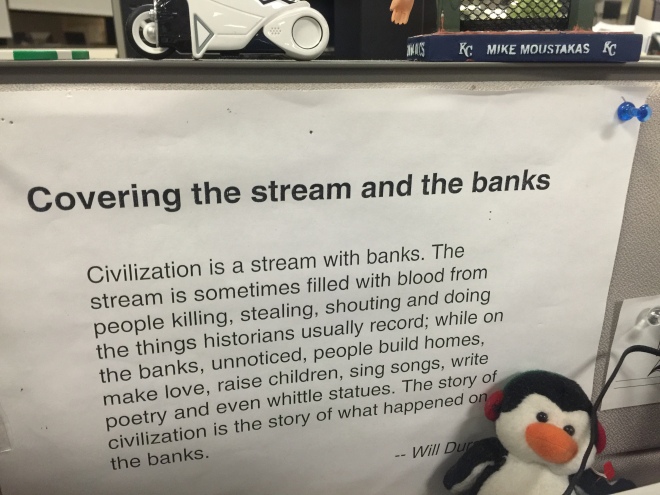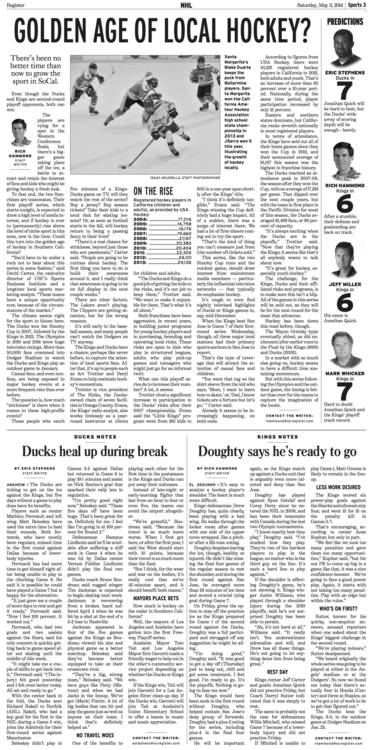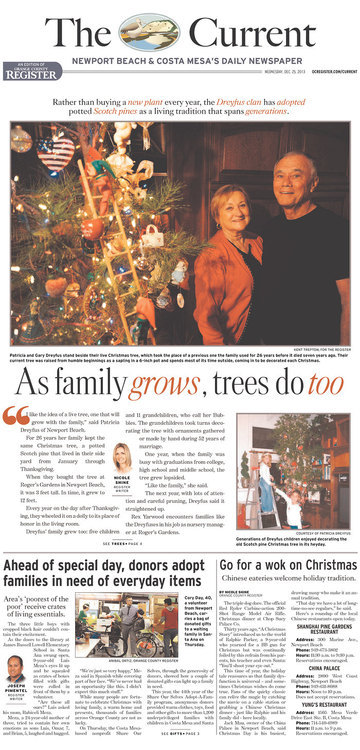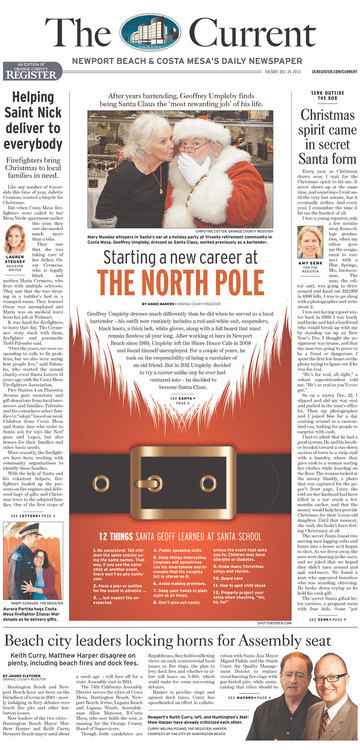I wasn’t one of the original online journalists.
It was around 1996 when I got involved in newspaper “new media” — which is what it was called back in the day. By that time, there were a ton of digital pioneers doing amazing and interesting things with news.
I’ve written tons about the original members of journalism’s Justice League— the first newspaper nerds. And I still get giddy when I talk with them.
But, with the help of some of the most gifted and dedicated journalists I’ve ever met, I have done a few things on the web over the last two decades, too.
Most people in the media world think of me as a digital journalist. For the longest time, this blog was called Internet Punk.
Technology always fascinated me when I was kid, but it never really inspired me. Inspiration came from words — words I read in one of the three newspapers my family subscribed to in Osage City, Kan.
I’ve wanted to be a reporter since the third grade. My heroes were an editor who died in 1944 and a folksy sportswriter who smoked cigars, played a lot of golf and wrote more than 8,500 columns for the paper I grew up reading religiously.
By the time I achieved one of my life goals in the mid 90s — to be a staff writer for the mighty Topeka Capital-Journal — things were already changing in the newspaper world. I knew a little bit about how the Internet worked and I was asked if I would like to help with our newspaper’s new website.
This was a hard decision because seeing my byline in The Capital-Journal was better than Christmas.
In 1931, William Allen White — one of those heroes — wrote this in a personal letter to Lyman B. Kellogg:
“Of course as long as man lives someone will have to fill the herald’s place. Someone will have to do the bellringer’s work. Someone will have to tell the story of the day’s news and the year’s happenings. A reporter is perennial under many names and will persist with humanity. But whether the reporter’s story will be printed in types upon a press, I don’t know. I seriously doubt it. I think most of the machinery now employed in printing the day’s, the week’s, or the month’s doings will be junked by the end of this century and will be as archaic as the bellringer’s bell, or the herald’s trumpet. New methods of communication I think will supercede the old.”
He knew 85 years ago that our industry must always evolve.
I decided to go all in on online newspapers.
I learned everything I could about the Internet and how to build websites. I drank gallons of Mountain Dew, listened to a ton of questionable music at even more questionable volumes, and rarely left our web team’s desks — which were buried in our newspaper’s morgue.
I did whatever I could to build the best website possible for the hometown newspaper I adored. It was one of the most rewarding times of my life. Just thinking about it is making me crave highly caffeinated green soda.
For the next 16 years, newspapering took me across the country. Working with lots of incredibly talented people, we built tons and tons of websites. Some were fantastic successes. Some were total bombs.
Either way, we learned.
But by the summer of 2012, I didn’t feel the passion anymore. I was out of my element and done with newspapers. And I was absolutely done with newspaper websites.
Then another one of my heroes, longtime Orange County Register editor Ken Brusic reached out to me. It’s a story for another time, but I’ve loved The Register since learning about it in college. And I loved Ken.
This was before the then-ownerless Register was purchased by Aaron Kushner and his 2100 Trust group. It didn’t matter to me that there was no stability at the paper. There wasn’t even a real job for me. The chance to work with Ken at The Register seemed worth it.
When Kushner’s team bought Freedom, it was made abundantly clear The Register wasn’t going to focus on digital. At all. The Register was only going to worry about paid subscribers. In print.
How was a digital journalist who loved local news and focused on audience trends going to figure into this plan?
I used to say all the time that the most important part of the word newspaper is “news” — not paper. We should love the journalism, not the medium. I was going to take my own advice.
Besides, Kushner’s ideas seemed interesting to me. They were completely contrary to nearly everything our industry said and did.
For most of my career, print revenues plunged and circulation numbers fell, all while whatever team I was a part of focused on the digital-delivery of newspaper content in the hopes of growing an audience and finding new ways to help pay for the journalism.
At this point in my life, after I’d been blessed to work with (and learn from) some of the smartest people in the newspaper industry, it now seemed clear no one had figured out how to solve this problem. It felt like no one would.
Why not see if someone else’s completely counterintuitive ideas could save newspapers?
I became a print editor at The Orange County Register. Ken gave me the greatest job description ever. It’s still thumbtacked to my desk:

Working right in the center of the newsroom, I fell even more in love with this newspaper and its people. In some ways, it was the first time I felt like a real part of a newsroom since I was a reporter back in Topeka.
And being able to watch online journalism from the outside, and visit news websites as just a reader, was not only informative, but also hugely valuable. In many ways, I learned more than when I was building websites.
When friends would visit The Register and see our newspaper, some joked our print edition felt and looked like a website printed in six columns.
There was probably something to that.
The Register plans its front pages the same way teams I worked with in the past planned for the 8 a.m. homepage. Even the stories we tell are “webby.” That’s not a euphemism for light or goofy. For me, “webby” means an understanding of what people actually read and how they read it.
This newspaper’s drama over the last few years has been well documented. At one point it was so stressful and heartbreaking, some nights would end with Donna Wares, The Register’s fantastic managing editor, and me asking each other: “Are you coming back tomorrow?”
We were both pretty sure the other was coming back, but it didn’t hurt to check.
A long time ago an editor at The Washington Post told me it’s easy to lead when things are going great, but real leaders lead when things are tough. I wasn’t sure I was a real leader, but I knew I had to try to be one. For as long as I could. Things certainly were tough, so this was definitely the time to learn.
Rich Mirman began running The Register’s day-to-day operations in October of 2014. By March of 2015, Kushner resigned — which was fascinating, because who knew an owner could resign? It was mostly ceremonial. Mirman was already in charge by that time.
With Mirman as our publisher, it became clear I was going to take over The Register’s websites and digital strategies. I was ready. More importantly, our newsroom was ready — even if it didn’t know it was.
I remember something the best programmer I’ve ever worked with used to say. He never called anything “hard.” He said it was “non-trivial.” Re-building The Register’s website was going to be non-trivial.
After a couple of years of only caring about print, The Register now had very limited technology and even fewer digitally focused folks.
At one time, The Register had a pretty darn good web team. But that team was long gone.
There used to be an entire floor in our building called Freedom Interactive, also filled with lots of smart people building all sorts of interesting digital tools. They were all laid off a week or so before before the new owners arrived in 2012.
Our newspaper isn’t exactly crawling with programmers now. The ones we have are really good, but hidden in a completely different building in the IT department.
Our newsroom computers are ancient — PCs that are at least seven or eight years old and run Windows XP, which was initially released in 2001 and Microsoft quit supporting in 2014. Only a handful of computers in our newsroom have enough RAM to run a modern operating system and Photoshop simultaneously without serious issues.
Some of our web servers are older than my eldest son, and he’s in middle school. We use a home-brewed online content management system originally written about a decade ago. A key part of our site runs on servers that are no longer made, from a company that is long gone, and the only way to keep them running is when our tech folks can find what they need on eBay.
The wifi access in our newsroom is so inconsistent and slow, many of us use T-Mobile mobile hotspots at our desks just to get on the web.
None of this is the fault of our IT team. They’ve known for years we needed new equipment. They requested it, spec’ed it out, sent out RFPs. And were always told the money wasn’t there to do it.
When I was at the 20,000-circ Lawrence Journal-World in 2003 and the 35,000-circ Topeka Capital-Journal in 2001, we had bigger web teams (both in the newsroom and on the tech side) than The Register now had. As a point of reference, The Register’s 2014 circulation numbers — according to the Alliance for Audited Media — were about 356,000.
The things listed above weren’t even our biggest problems.
Under Kushner’s regime, The Register announced in April of 2013 that it wasn’t just going to have a paywall on its website — it was going to have one of the most-restrictive paywalls of any news site on the web.
We were going to stop chasing the digital ghost.
If you did get to the stories and photos behind our heavy-duty paywall, you then hit tons of “pagination” — meaning even a short story would be broken into multiple pages.
Many moons ago, when The Register focused on digital, huge parts of the newspaper’s site sat on Word Press blogs. In 2012, those blogs were shut down. Thousands and thousands of pages from our archives were wiped out with the flip of a switch.
And when you dug into our site’s code, and looked closely at the index pages and story pages, you saw lots of recently added things that other folks would call “black hat SEO.”
Actually, everyone who works on the web would call it that.
Believe it or not, this all made building a new website for The Register more appealing.
We had no legacy digital assets to protect. The Register’s online revenues, web audience and digital reputation — developed over decades — were basically gone. And for the cyber sins committed, this newspaper’s website was absolutely dead to Google.
It sounds horrible. And it is. But it’s also very freeing.
It meant we could build what a newspaper might try to build now, knowing what we know now, instead of adding on to what we initially built in the ‘90s. We didn’t have to worry about breaking something that was now a huge part of our newspaper’s online strategy and bottom line because all of that had already been destroyed.
We developed a plan. We shared it with everyone at the newspaper who wanted to hear it.
We talked about how we would need to iterate on our site. Things would roll out on our site as they were completed. Or almost completed. Or at least kinda working. And we would improve them.
When things launched on our site, we would tweak them in full public view. Doing it this way, based upon the limited resources we had, would likely take about 18 months before it would start to be obvious we had made real changes.
That process started in October of 2014. By Thanksgiving of that year, key pieces of the site’s code had been re-written and the paywall was completely gone. The Register’s site basically looked the same, but it now had different guts.
Through all of this web development, we kept our mouths shut.
Even when we had built something pretty dang cool, we didn’t talk about it. We didn’t write stories about it. We didn’t run house ads in our newspaper about it. We were quiet.
When we initially outlined our new digital strategy, we decided we weren’t going to tell people what we were building. We were going to show them. After it was done.
While the newsroom and our tech team was doing all of this, Mirman was leading a fascinating turnaround of our newspaper’s finances. The differences in the year-to-year numbers were eye-popping.
The problem was the hole he inherited was simply too deep.
In November of 2015, The Register’s parent company declared bankruptcy for the second time in six years.
In all likelihood, we’ll emerge from bankruptcy by the end of March.
So, what about our 18-month web strategy? All along, we thought we’d begin promoting parts of it in April of 2016. The content and technology parts are on schedule.
But that April date looks important now for very different reasons.
So, starting this week — and over the next month or so — I’m going to write about the things I’ve watched this inspiring newsroom and inventive tech team create.
It’s not easy doing this kind of stuff even when you have unlimited resources. That’s why well-funded dot-coms still fail. It’s also why I can’t wait to show you what was built here out of almost nothing.
It’s not unusual for someone to recommend an expensive bottle of wine at dinner and seem smart. But the much more impressive sommelier is the one who suggests a $10 bottle the whole table ends up loving and remembering.
That’s how we’re building our digital strategy — low budget, but tasty and, I hope, memorable.
I can’t wait to share what we’ve been working on. And I can’t wait to tell you about the great people at The Register who built it all.



















































You must be logged in to post a comment.